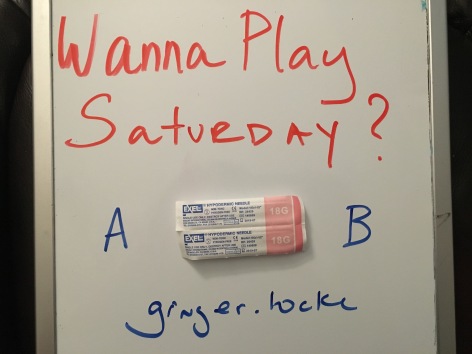This is the blog conclusion to the “Wanna-Play-Saturday” posting on my Facebook page.
In case you missed the original post, I’ll catch you up: In summary, I’ve watched paramedic students struggle with the little opening-flaps on the needle below.
So, I decided to ask experienced providers:
Which side would you think has the opening-flap?

Like the novices, experienced providers also want to open the “flapless” side B. With the graduated coloring, side B looks like an obvious choice for a flap.
But that’s not where the flap is!

In this YouTube video, I describe the engineering problem as I perceive it and promise to call EXEL international.
I called them, or rather emailed them, today.
Using their general information email, I sent a short message and included the Youtube video.
I fully expected no response as I figured they’d (correctly) pick up on the fact that I’ve been obsessing over the topic.
Within a few hours of the email, a call from California popped up on my phone.
“Is this Ginger Locke?”
“Yes.”
“We watched your video.”
He was gracious and said they encourage feedback like ours. His suggested solution was that they add the words “open here” to the white end and then the user…
(it’s hard to type the next part)…
“will have no excuse to not understand where to open it.”
Silence from my end.
It was then that knew I wasn’t talking to someone who had drawn up benzos with a combative patient in the back of an ambulance or Epi for pediatric anaphylaxis. I wanted to respond with:
“Say What?!”
Instead, I advocated, that in Emergency Medicine, providers often rely on colors, symbols and subtle patterns to get clues about how equipment works.
EMS is a multi-sensory sport. During rapid information-gathering under stress, written text gets blurry in the interest of letting other senses play: touch, smell, hearing.
Human in the System, a company that provides expert coaching in the field of human factors, was spot on with this hypothesis about why EXEL International packaging looks the way it does:
Why is the flap for opening on side marked “A”? Color looks like flap. @HumaninSystem @healthcarehf @HumanFact0rz pic.twitter.com/c0BbyeJX47
— Ginger Locke (@gingerlockeATX) March 7, 2016
@gingerlockeATX@healthcarehf@HumanFact0rz Because a marketing person designed it and not a user?
— HumanintheSystem (@HumaninSystem) March 7, 2016
The mind of a medic is a talented computer.
It recognizes patterns and acts with profound speed. If you find yourself fumbling over and over with a device, this may say more about the inherent shortcomings of the device design than about your brain.
